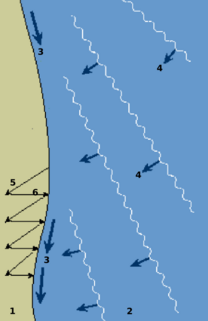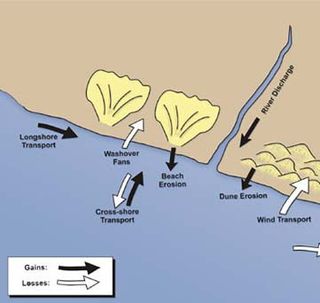Related Research Articles

An estuary is a partially enclosed coastal body of brackish water with one or more rivers or streams flowing into it, and with a free connection to the open sea.

A river delta is a landform created by deposition of sediment that is carried by a river as the flow leaves its mouth and enters slower-moving or stagnant water. This occurs where a river enters an ocean, sea, estuary, lake, reservoir, or another river that cannot carry away the supplied sediment. The size and shape of a delta is controlled by the balance between watershed processes that supply sediment, and receiving basin processes that redistribute, sequester, and export that sediment. The size, geometry, and location of the receiving basin also plays an important role in delta evolution. River deltas are important in human civilization, as they are major agricultural production centers and population centers. They can provide coastline defense and can impact drinking water supply. They are also ecologically important, with different species' assemblages depending on TX tyvychchc
landscape position.

A salt marsh or saltmarsh, also known as a coastal salt marsh or a tidal marsh, is a coastal ecosystem in the upper coastal intertidal zone between land and open saltwater or brackish water that is regularly flooded by the tides. It is dominated by dense stands of salt-tolerant plants such as herbs, grasses, or low shrubs. These plants are terrestrial in origin and are essential to the stability of the salt marsh in trapping and binding sediments. Salt marshes play a large role in the aquatic food web and the delivery of nutrients to coastal waters. They also support terrestrial animals and provide coastal protection.

Longshore drift from longshore current is a geological process that consists of the transportation of sediments along a coast parallel to the shoreline, which is dependent on oblique incoming wave direction. Oblique incoming wind squeezes water along the coast, and so generates a water current which moves parallel to the coast. Longshore drift is simply the sediment moved by the longshore current. This current and sediment movement occur within the surf zone. The process is also known as littoral drift.

The Ōreti River is one of the main rivers of Southland, New Zealand, and is 170 kilometres (110 mi) long. The river has been identified as an Important Bird Area by BirdLife International because, for much of its length, it supports breeding colonies of black-billed gulls.

The Manawatū River is a major river of the lower North Island of New Zealand. The river flows from the Ruahine Ranges, through both the Manawatū Gorge and the city of Palmerston North, and across the Manawatū Plains to the Tasman Sea at Foxton.

Sedimentary budgets are a coastal management tool used to analyze and describe the different sediment inputs (sources) and outputs (sinks) on the coasts, which is used to predict morphological change in any particular coastline over time. Within a coastal environment the rate of change of sediment is dependent on the amount of sediment brought into the system versus the amount of sediment that leaves the system. These inputs and outputs of sediment then equate to the total balance of the system and more than often reflect the amounts of erosion or accretion affecting the morphology of the coast.
The Waitakaruru River is a river of the Waikato Region of New Zealand's North Island. It flows initially north before turning northwest across the northwestern corner of the Hauraki Plains, reaching the southwestern corner of the Firth of Thames close to the settlement of Waitakaruru.
The Waingaro River is a river of the Waikato region of New Zealand's North Island. It flows generally southwest from its origins near Glen Afton and Glen Massey, west of Ngāruawāhia, to reach a northern arm of Raglan Harbour. Its main tributary is Kahuhuru Stream, which Highway 22 follows for several kilometres. Tributaries total about 170 kilometres (110 mi). At Waingaro it is fed by a hot spring.
Abarenicola pacifica or the Pacific lugworm is a large species of polychaete worm found on the west coast of North America and also in Japan. The worms live out of sight in burrows under the sand and produce casts which are visible on the surface.

Neanthes arenaceodentata is a species of marine polychaete worm in the family Nereididae. It occurs in shallow waters in the tropical Atlantic and Pacific Oceans. It has been used in the laboratory in testing the toxicity of marine sediments.
Prionospio aucklandica is a spionid worm. Prionospio aucklandica is distributed throughout New Zealand.
Goniadidae is a family of marine worms within the Polychaeta. Goniadids have long, slender bodies and can grow up to 260mm in length, although most are less than 50mm long. Goniadids have an eversible proboscis with a circlet of chitinous jaws around the terminal end.
Aricidea is a genus of small paraonid worms, which are sub-surface deposit feeders and bioturbators. Aricidea worms have a prostomial antenna, with all Aricidea species possessing neuropodial thickened chaetae.
Magelona dakini is a small, thin, shovel-nosed burrower with limited mobility. Adults grow up to 70mm long. Magelonids build meandering burrows, usually below the top 20mm of sediment, in medium to fine sands. They occur across the mid-intertidal and subtidal zones to the continental slope.
Cossura consimilis is a polychaetid worm that was distributed throughout New Zealand. Cossura consimilis is a slender thread-like worm with a blunt head, growing up to 20mm in length. Cossura consimilis live in muddy sand in shallow intertidal harbours and estuaries, to the inner continental shelf and out to the continental slope. Cossura consimilis tolerates a sediment mud content of 5 to 65%, with an optimum range of 20-25%.
Orbinia papillosa is a polychaetid worm distributed throughout New Zealand. Orbinia papillosa has a small pointed head without eyes. Adults can grow in size to more than 100mm long, but are less than 2mm in width.
Linucula hartvigiana, commonly known as clam nut or nut shell, is a bivalve mollusc. Linucula hartvigiana has a brown oval shell and grows up to 6-8mm in width. Linucula hartvigiana is found in unpolluted subtidal and intertidal muddy-sand habitats throughout New Zealand.
Theora lubrica is a bivalve mollusc endemic to the Northwest Pacific, including northern Japan, southern Russia and Hong Kong. It was introduced into harbours around the North Island of New Zealand around 1972, and has since spread to the upper South Island. It has also been introduced to California, Australia, the Mediterranean Sea and the Atlantic Sea.
References
- ↑ Estcourt, I (1967). "Burrowing polychaete worms from a New Zealand estuary". Transactions of the Royal Society of New Zealand. 9 (7): 65-78.
- 1 2 Singleton, Nathan (2010). Regional Estuary Monitoring Programme (REMP) Data Report: Benthic Macrofauna Communities and Sediments – July 2007 to April 2008 (Report). Waikato Regional Council. Retrieved 2021-02-18.